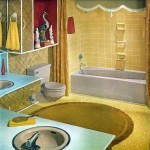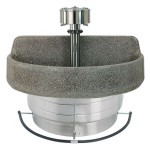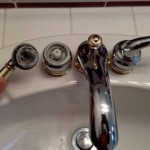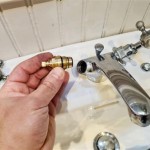How To Get Rid Of Mould On Bathroom Walls
Mould growth on bathroom walls is a common household problem, often exacerbated by high humidity, poor ventilation, and temperature fluctuations. Identifying and addressing the underlying causes while implementing effective cleaning techniques are crucial for long-term mould prevention and maintaining a healthy bathroom environment. This article provides a comprehensive guide to removing mould from bathroom walls and preventing its recurrence.
Before attempting any mould removal, it is important to understand the potential health risks associated with mould exposure. Mould spores can trigger allergic reactions, respiratory problems, and other health issues, particularly in individuals with pre-existing sensitivities or compromised immune systems. Therefore, taking appropriate precautions during the cleaning process is essential to minimize exposure and protect personal health.
Proper preparation is critical for effective and safe mould removal. This includes gathering necessary cleaning supplies, ensuring adequate ventilation, and wearing appropriate protective gear. Neglecting these steps can lead to ineffective cleaning, further mould contamination, or potential health hazards.
Preparing for Mould Removal
The initial step involves gathering the necessary supplies. These include: *
Cleaning Solution:
Choose from various options such as bleach solution (1 part bleach to 10 parts water), vinegar, hydrogen peroxide, or commercial mould removal products. The selection should be based on the severity of the mould growth and the type of surface being cleaned. *Protective Gear:
Wear gloves, a face mask (N95 or equivalent), and eye protection to minimize exposure to mould spores. *Cleaning Tools:
Gather scrub brushes (non-abrasive), sponges, spray bottles, and cloths. *Ventilation:
Ensure adequate ventilation by opening windows and doors and using a fan to circulate the air. This helps to remove airborne mould spores and reduce humidity levels during the cleaning process. *Garbage Bags:
Employ garbage bags for the disposal of contaminated materials such as sponges and cloths used during cleaning.Prior to commencing the cleaning process, it is advised to test the chosen cleaning solution on a small, inconspicuous area of the wall. This helps to ensure that the solution does not damage or discolor the surface. Wait for a few minutes to observe any adverse reactions before proceeding with the full cleaning procedure.
Cleaning Mould from Bathroom Walls
After the preparation phase, the actual cleaning process involves carefully applying the chosen cleaning solution to the affected areas and thoroughly scrubbing the mould. This removes the visible mould and helps to kill the remaining spores.
The detailed cleaning steps include:
-
Applying the Cleaning Solution:
Spray the chosen cleaning solution onto the mould-affected areas of the wall, ensuring complete coverage. Allow the solution to sit for several minutes (typically 10-15 minutes) to penetrate the mould and loosen its grip on the surface. -
Scrubbing the Mould:
Use a scrub brush or sponge to vigorously scrub the mould-affected areas, focusing on removing all visible mould growth. Apply moderate pressure while scrubbing, but avoid excessive force that could damage the underlying wall surface. -
Rinsing the Wall:
After scrubbing, rinse the wall thoroughly with clean water. This removes any remaining cleaning solution and dislodged mould spores. Use a clean sponge or cloth to wipe down the wall and ensure that no residue remains. -
Drying the Wall:
Thoroughly dry the wall using a clean towel or cloth. Alternatively, use a fan to circulate air and expedite the drying process. It is important to ensure the wall is completely dry to prevent further mould growth. -
Inspection:
After the wall is dry, inspect the cleaned areas for any remaining signs of mould. If mould persists, repeat the cleaning process as needed.
For persistent or extensive mould growth, it is advised to consider using a stronger cleaning solution or seeking professional mould remediation services. Professional services have specialized equipment and expertise to handle severe mould infestations safely and effectively.
Preventing Future Mould Growth
Preventing mould recurrence is crucial for maintaining a healthy bathroom environment. This involves addressing the underlying causes of mould growth, such as high humidity and poor ventilation, and implementing proactive measures to control moisture levels.
Key preventative measures include:
-
Improving Ventilation:
Ensure adequate ventilation in the bathroom by opening windows and doors during and after showers or baths. Install or upgrade the bathroom exhaust fan to effectively remove moisture-laden air. Run the exhaust fan for at least 20 minutes after showering or bathing. -
Controlling Humidity:
Consider using a dehumidifier to reduce humidity levels in the bathroom, particularly in humid climates or during periods of high humidity. Regularly monitor humidity levels using a hygrometer and aim to maintain levels below 60%. -
Repairing Leaks:
Promptly repair any leaks in the bathroom, including leaky faucets, showerheads, and pipes. Water leaks provide a constant source of moisture that promotes mould growth. -
Regular Cleaning:
Clean bathroom surfaces regularly to remove soap scum, dirt, and other organic matter that can serve as a food source for mould. Pay particular attention to areas prone to mould growth, such as shower walls, grout lines, and ceilings. -
Using Mould-Resistant Products:
Consider using mould-resistant paint and grout in the bathroom to inhibit mould growth. These products contain additives that resist mould and mildew. Properly seal grout lines to prevent water penetration. -
Wiping Down Surfaces:
After showering or bathing, wipe down wet surfaces, such as shower walls and doors, to remove excess moisture. This helps to reduce humidity levels and prevent mould from gaining a foothold. -
Allowing Items to Dry Completely:
Ensure that bath mats, towels, and other items are allowed to dry completely between uses. Damp items can provide a breeding ground for mould and mildew. Regularly wash bath mats and towels and replace them when they show signs of wear and tear.
Maintaining a clean and dry bathroom environment is a continuous effort. By implementing these preventative measures and addressing the underlying causes of mould growth, homeowners can significantly reduce the risk of mould recurrence and maintain a healthy and hygienic bathroom.
The composition of the walls themselves can contribute to mould growth. Porous materials like drywall are more susceptible to moisture absorption compared to non-porous materials like tile. Proper sealing and painting of walls with mould-resistant paint can significantly reduce their susceptibility to moisture and mould.
Understanding the type of mould present can also influence the cleaning approach. While many household moulds are relatively harmless, some species can be more toxic. If there is concern about the type of mould present, it is advisable to consult a professional for testing and remediation advice.

How Do You Get Rid Of Mould On Bathroom Walls Igloo Surfaces

How To Get Rid Of Mold In Bathroom 2024 Tips From Puroclean

How To Get Rid Of Mold In The Shower On Bathroom Walls Clorox

Bathroom Ceiling Mold Removal When To Clean Call Branch Environmental

How To Get Rid Of Black Mold In Bathrooms

How To Remove Mold From Walls True Value

How To Remove Mold From Bathroom Walls 6 Cleaning Tips

The Ultimate Guide On How To Clean And Get Rid Of Mold Pro Housekeepers

A Handful Of Ways To Remove Mold On Bathroom Walls Clean Water Partners

Black Mold In The Shower How To Clean It Kitchen With Matt
Related Posts







